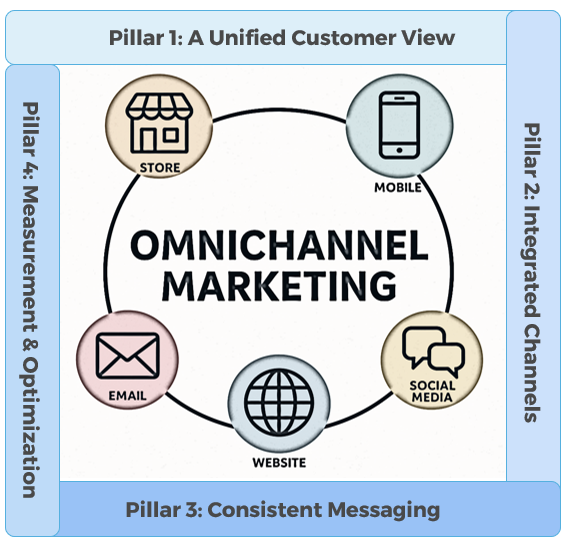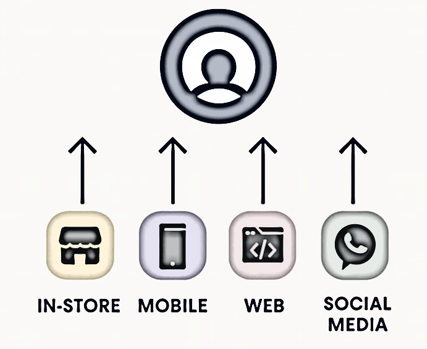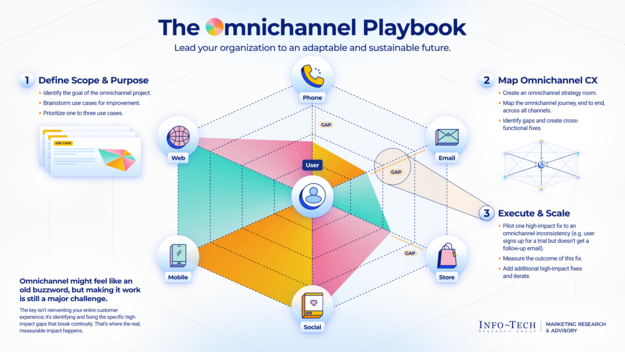Today's customers move seamlessly across digital and physical touchpoints, yet the organizations serving them remain structured in silos.
- Customer experiences are disconnected, inconsistent, and out of step with expectations.
- Teams lack visibility into the full end-to-end journey and where friction occurs.
- Platforms do not communicate, and customer data remains siloed.
- Personalization is often based on assumptions instead of data.
Our Advice
Critical Insight
Omnichannel isn't dead; it's just hard to get right. Most strategies fail not because of vision, but because of execution gaps. The real value lies in fixing the specific breakdowns that cause friction, disconnect data, and weaken personalization. This playbook focuses on practical steps to close those gaps fast and deliver seamless, measurable CX improvements.
Impact and Result
- Create a clear omnichannel roadmap strategy that connects teams, platforms, and data to deliver a consistent, customer-first experience.
- Prioritize and fix high-friction pain points fast using a repeatable, scalable strategy.
- Drive measurable gains in engagement, retention, and revenue in 90 days or less.
The Omnichannel Playbook
91��Ƭ�� an omnichannel strategy that fixes CX friction fast and delivers cross-channel consistency
Bridging the gap from omnichannel strategy to execution
Customer experience (CX) expectations have fundamentally changed, but most operating models haven't. Today's customers move seamlessly across digital and physical touchpoints, yet the organizations serving them remain structured in silos.
The result? Experiences that feel inconsistent, disconnected, and increasingly out of sync with what customers demand. While most firms have an omnichannel strategy in teory, few have a functioning system in practice.
Focus your omnichannel strategy on solving specific, tangible pain points across channels, not on creating a broad CX vision. Omnichannel success comes from fixing targeted gaps in continuity and consistency and driving measurable improvements in the customer journey, not from redefining your entire customer experience strategy.
This research helps organizations move from aspiration to action. It offers a practical execution roadmap to align people, data, and decisions across departments around a unified experience vision – a roadmap that's measurable, repeatable, and capable of producing results in 90 days.

Terra Higginson
Principal 91��Ƭ�� Director
91��Ƭ��
Overcome the omnichannel execution challenge
| Pain Points | Obstacles | Info-Tech's Approach |
|
Customer experience expectations have fundamentally changed, but most operating models haven't kept pace with the rapid changes. Today's customers move seamlessly across digital and physical touchpoints, yet the organizations serving them remain structured in silos.
|
While most firms have an omnichannel strategy in theory, few have a functioning system in place. Common obstacles include.
|
The gap between the intent of an omnichannel strategy and executed reality is now the single biggest barrier to delivering customer-first outcomes. This research helps organizations move from aspiration to action. It offers:
|
91��Ƭ�� Insight
Omnichannel might feel like an old buzzword, but making it work is still a major challenge. The key isn't reinventing your entire customer experience; it's about identifying and fixing the specific high-impact gaps that break continuity. That's where the real, measurable impact happens.
Keep up with the expectations of customers in the omnichannel era
Missed expectations are not simply marketing or service problems; they're execution failures stemming from disjointed omnichannel systems, misaligned roles, and unclear ownership. Consistency isn't just about quality. It's about trust. And trust erodes silently with every inconsistent moment.
Inconsistent Experiences Erode Trust, Quietly and Quickly
Inconsistent Experiences Erode Trust:
- Customers don't see your internal structure; they feel its consequences. And they don't complain loudly; they just don't come back.
Customers Encounter Common Friction Points:
- A product that is priced one way online, another in store.
- A loyalty program that doesn't sync across touchpoints.
- A "personalized" recommendation that misses the mark.
Execution Stalls Inevitably When:
- Teams don't know what "good" looks like at each touchpoint.
- Functions interpret customer data differently.
- Feedback loops break down before they reach action.
Nieman Marcus case study: The cost of inaction
Fragmented omnichannel execution can topple even the strongest brands.
When a Weak Links Break: The Neiman Marcus Omnichannel Failure
Malcolm Gladwell contrasts strong-link systems (where top performers carry the burden) with weak-link systems (where overall success depends on shoring up the lowest-performing parts).
Omnichannel is an example of a weak-link system: Every touchpoint and handoff must work reliably, even the weakest link, to deliver a seamless customer experience.
A Luxury Retail Cautionary Tale
- Burdened with debt and physical stores, the Nieman Marcus Group filed for Chapter 11 in May 2020, not just because of the COVID-19 pandemic, but from long-term digital misalignment.
- Despite Nieman Marcus' reputation for luxury and significant tech investment, execution gaps in omnichannel, especially between online browsing, inventory visibility, and in-store service, eroded customer trust and transactional reliability.
- The company emerged stronger, but only after a $500 million tech investment and structural overhaul. This was a repair job caused by neglecting execution gaps.
Omnichannel Outcome
Brands that build omnichannel alignment into their operations can systematically close experience gaps, build long-term resilience across channels, and prevent weak links destroying the value of the entire system.
Execution Failures vs. the Omnichannel Winning Playbook
| Failure at Weak Links | Omnichannel Response |
| Disconnect between online and physical experience hampers the fulfillment of promises | Unified inventory and order orchestration from online to physical |
| Support agents lacked cross-channel visibility | Shared customer profiles and role clarity |
| Offers were inconsistent across channels | Centralized pricing, promotion, and SLA governance |
Source: Forbes, 2020
Why even the best omnichannel strategies fail to execute
Behind every broken experience is a broken operating model. This is not from lack of effort, but from a lack of orchestration across channels.
| The Area | What's Going Wrong | The Customer Impact |
| Teams | No shared goals or incentives | Disjointed service and inconsistent tone across various channels |
| Data | Incomplete or inaccessible | Repetitive or irrelevant interactions across various channels |
| Decisions | Made in silos | Conflicting offers or messages across channels, such as online and in store |
The four pillars of omnichannel marketing
A strong omnichannel strategy requires more than presence across channels. It demands a unified, customer-first approach built on these four pillars:
1. A Unified Customer View
Customers expect brands to know who they are. Every interaction should reflect a complete picture of their journey, including what they've done, what they need, and what they care about.
2. Integrated Channels
Switching between channels shouldn't feel like starting over. When channels are connected, customers can move seamlessly between them. Brands can respond in real time, wherever customers show up.
3. Consistent Messaging
Different teams shouldn't sound like different companies. Messaging that feels coordinated builds trust, reinforces your brand, and helps customers feel understood across every touchpoint.
4. Measurement & Optimization
A great customer experience isn't one and done. Tracking what works and what doesn't keeps teams aligned and focused on what matters most. It's how you make every interaction better than the last.

Image source: Sora, July 2025
Activate a unified customer view
A unified view of the customer creates a single source of truth.
Customer Intelligence
Ensure that teams from marketing to sales to service to product can access this unified view. Strategy sits at this layer to connect tech into actionable insights and revenue drivers.
Contextual Identity
Move from static segments to behavior-driven personas and real-time data to see where customers are at in that moment and use AI to predict where they are headed. Digital analytics platforms excel in dynamically creating cohorts.
Consolidated Customer Profiles
Bring together data from web, mobile, brick and mortar, service desk, and third-party to create a consolidated customer profile. Often this is done using CRM and CDP solutions.
Move from fragmented to omnichannel
Current State: Disjointed and Disgruntled
Disconnected channels emphasize the organization's processes rather than the customer's, and messages are inconsistent. It is a fragmented customer experience that creates inefficiencies and frustration.

Future State: Integrated and Enlightened
Channels are unified, with the customer at the center. Consistent, personalized messaging is delivered at the right time, on the right channel, every time. A unified view provides consistency, insight, and effective interactions.

Image source: Sora, July 2025
91��Ƭ�� consistent messaging with content planning in omnichannel
The 91��Ƭ��ing Blocks of a High-Performing Omnichannel Content Plan:
- Clear Branding
Your unique value proposition, tone of voice, and core messaging pillars are clearly defined and consistently applied. - Defined Audience with Channel Preferences
You have a well-defined audience or persona, with a strong understanding of their pain points, preferences, and the channels they prefer for communication. - Mapped Customer Journey With Key Messaging
Your content aligns to key moments across the customer journey. Each stage is supported with relevant content types and clear messaging tied to specific objectives. - Centralized Content Calendar
A master content calendar ensures alignment in timing, themes, and ownership across all channels, and never forget the call to action for each piece. - Aligned Messaging Across Teams
Marketing, sales, and service teams are aligned on audience insights, messaging priorities, and key themes. Messages are adapted (not reinvented) for each platform's style while staying consistent.
Multi-touch attribution is the flat earth of marketing measurement
Many jobs have been lost trying to perfect multi-touch attribution, a long and often impossible task. Until the day we have chips in our brains that capture everything we see, hear, and feel, true attribution will remain a difficult and unsolved puzzle.
Multi-touch attribution is overly simplistic for today's complex, omnichannel reality. It ignores the true complexity of human decision-making and how customers move non-linearly across touchpoints.
Instead of chasing perfection in multi-touch attribution, we recommend marketing mix modeling (MMM). MMM provides a high-level statistical view over time to help understand which combination of channels drives long-term growth and ROI. It controls for external factors and offers a more reliable foundation for strategic decision-making.
If running regression models isn't feasible, focus on customer-centric metrics like:
- Net Promoter Score (NPS)
- Retention
- Customer Lifetime Value (CLV)
- Customer Acquisition Cost (CAC)
These metrics provide clear, actionable insights tied directly to business performance, without the false precision of attribution models.
Stop measuring clicks, start measuring completion

Too many omnichannel initiatives are measured with the wrong metrics, such as clicks, impressions, or lagging NPS scores. These offer insight, but not action. What's needed is a shift from output measurement to confidence measurement. These are the signals that tell you if the system is working in real time.
Journey Completion
95%
Can the customer actually finish what they came to do?
3.5 min
Resolution Time
Are there consistent experiences across channels?
87%
Health Signals
These numbers are illustrative; your benchmarks and metrics will vary based on your industry and goals. If you need assistance establishing these metrics, please consult with an analyst.
Get to the omnichannel opportunities faster, destroy roadblocks, and build a strategy that works
Get to "go" faster. 91��Ƭ�� your omnichannel strategy room.
- Divide into cross-functional teams (Marketing, Product, Service, Sales, Ops) and each present a scenario (e.g. cart abandonment + store visit).
- Ask each group the following questions:
- What do you need for each team to do to ensure this customer converts?
- What data/tools do you need from other teams?
- How would you know it worked?
- Debrief with a one-page Omnichannel Strategy Roadmap template from The Omnichannel Strategy Playbook Template.
Use agentic AI to accelerate omnichannel execution
Remember to automate responsibly.
AI is a copilot, not the driver.
Faster Journey Discovery
Map real customer behavior, not assumptions.
Outcome: Prioritize the right journeys and fix what matters most.
Tools: Qualtrics, Heap, Amplitude
Smarter Signal Prioritization
Use AI to extract themes from support chats, surveys, and behavior logs.
Outcome: Surface top friction points in days, not weeks.
Tools: Adobe Journey Optimizer, Salesforce Einstein
Targeted Personalization
AI adapts offers, content, or routing based on live context.
Outcome: Drive relevance without overengineering journeys.
Tools: Segment, Mutiny
Predictive Experience Metrics
Forecast churn, drop-off, or service failures before they happen.
Outcome: Take action earlier and reduce experience breakdowns.
Tools: Mixpanel, Totango
A true omnichannel CX requires a fully integrated tech stack
| Function | Primary Technology | Omnichannel Value |
| Customer Data Integration | CDP | Unified view of customers for personalized engagement |
| Campaign Automation | Marketing automation (HubSpot, Salesforce, etc.) | Seamless, personalized messaging across all touchpoints |
| Real-Time Inventory | Enterprise resource planning (ERP) and point of sale (POS) systems | Consistent stock visibility across digital and physical |
| Unified Customer Profiles | CRM systems | Connect customer identity across channels |
| Fulfillment Tracking | Order management system (OMS) | Real-time visibility of orders, status updates |
| In-Store Technology | Clienteling apps, mobile POS | Connect store data to digital profiles and journeys |
| Agentic AI/Intelligence | Custom AI solutions | Predictive insights and personalization at scale |
Fix what customers feel, not just what you see
Don't stop at analyzing the journey. Feel it from the customer's side.
1 CX Mapping + Internal Teams
Map customer journeys with internal processes that directly impact the touchpoints.
2 Critical Gap Analysis
Focus on high-impact breakdowns in the customer journey, identifying where breakdowns cause the most harm to the customer experience.
3 Agile Prioritization
Address one high-friction pain point first, then move to the next one. Be agile.

 Marketing Management Suite Software Selection Guide
Marketing Management Suite Software Selection Guide
 Social Media
Social Media
 91��Ƭ�� IT Capabilities to Enable Digital Marketing Success
91��Ƭ�� IT Capabilities to Enable Digital Marketing Success
 Select and Implement a Social Media Management Platform
Select and Implement a Social Media Management Platform
 Develop a Web Experience Management Strategy
Develop a Web Experience Management Strategy
 Optimize Lead Generation With Lead Scoring
Optimize Lead Generation With Lead Scoring
 Create a Buyer Persona and Journey
Create a Buyer Persona and Journey
 91��Ƭ�� a More Effective Go-to-Market Strategy
91��Ƭ�� a More Effective Go-to-Market Strategy
 Leverage Web Analytics to Reinforce Your Web Experience Management Strategy
Leverage Web Analytics to Reinforce Your Web Experience Management Strategy
 2020 Applications Priorities Report
2020 Applications Priorities Report
 Diagnose Brand Health to Improve Business Growth
Diagnose Brand Health to Improve Business Growth
 Get Started With Customer Advocacy
Get Started With Customer Advocacy
 Pick Your Price Model
Pick Your Price Model
 Diagnose and Optimize Your Lead Gen Engine
Diagnose and Optimize Your Lead Gen Engine
 Develop the Right Message to Engage Buyers
Develop the Right Message to Engage Buyers
 Identify the Customer Satisfaction Metrics That Matter
Identify the Customer Satisfaction Metrics That Matter
 Create an Effective SEO Keyword Strategy
Create an Effective SEO Keyword Strategy
 Accelerate Business Growth and Valuation by 91��Ƭ��ing Brand Awareness
Accelerate Business Growth and Valuation by 91��Ƭ��ing Brand Awareness
 Social Media Management Software Selection Guide
Social Media Management Software Selection Guide
 91��Ƭ�� a More Effective Brand Architecture
91��Ƭ�� a More Effective Brand Architecture
 91��Ƭ�� Competitive Intelligence for Market Success
91��Ƭ�� Competitive Intelligence for Market Success
 Create Assets to Accelerate the Buyer Journey
Create Assets to Accelerate the Buyer Journey
 Brand Strategy: Establish and Cultivate a Flourishing Brand
Brand Strategy: Establish and Cultivate a Flourishing Brand
 91��Ƭ�� Your Account-Based Marketing Strategy
91��Ƭ�� Your Account-Based Marketing Strategy
 91��Ƭ�� Investor Awareness to Secure Next-Round Financing
91��Ƭ�� Investor Awareness to Secure Next-Round Financing
 Improve Win Rates With a Sales Enablement Strategy
Improve Win Rates With a Sales Enablement Strategy
 Scale Your Marketing Department
Scale Your Marketing Department
 Redesign Your Website to Increase Business Value
Redesign Your Website to Increase Business Value
 Choose the Right Channel Sales Partner
Choose the Right Channel Sales Partner
 91��Ƭ�� a Strong Analyst Relations Foundation
91��Ƭ�� a Strong Analyst Relations Foundation
 Improve External PR Communications for Greater Product Launch Success
Improve External PR Communications for Greater Product Launch Success
 Turn Share of Voice Growth Into a Strategic Weapon
Turn Share of Voice Growth Into a Strategic Weapon
 Optimize the Right Metrics to Scale Your Business
Optimize the Right Metrics to Scale Your Business
 Leave a Lasting Impression With a Compelling Brand Identity
Leave a Lasting Impression With a Compelling Brand Identity
 Hire Your Marketing Dream Team
Hire Your Marketing Dream Team
 Match Your Budget to Your Market Position
Match Your Budget to Your Market Position
 Capitalizing on AI
Capitalizing on AI
 Generative AI Use Cases for Marketing, Sales, and Customer Service
Generative AI Use Cases for Marketing, Sales, and Customer Service
 The AI Advantage for Smarter Marketing – A Primer
The AI Advantage for Smarter Marketing – A Primer
 91��Ƭ��, Buy, or Shut It Down
91��Ƭ��, Buy, or Shut It Down
 Event Activation Playbook
Event Activation Playbook
 Crush Your Product Launch
Crush Your Product Launch
 Go-to-Market Strategy on a Page
Go-to-Market Strategy on a Page
 Maximize ROI on Sales and Marketing Collateral
Maximize ROI on Sales and Marketing Collateral
 From Silos to Synergy: Create Marketing and IT Alignment
From Silos to Synergy: Create Marketing and IT Alignment
 Competitive Intelligence Software Selection Guide
Competitive Intelligence Software Selection Guide
 The Power of Segmentation
The Power of Segmentation
 Revolutionize Your Customer Onboarding
Revolutionize Your Customer Onboarding
 Search Engine Optimization Software Selection Guide
Search Engine Optimization Software Selection Guide
 91��Ƭ�� Better Dashboards Across Marketing, Sales, and Customer Success
91��Ƭ�� Better Dashboards Across Marketing, Sales, and Customer Success
 Make the Case for RevOps
Make the Case for RevOps
 The First 90 Days as a CMO
The First 90 Days as a CMO
 Stay Relevant in the Era of AI-Powered Search
Stay Relevant in the Era of AI-Powered Search
 91��Ƭ�� Your Product-Led Growth Playbook
91��Ƭ�� Your Product-Led Growth Playbook
 Elevate Analyst Relations
Elevate Analyst Relations
 Level Up Your Social Media Game
Level Up Your Social Media Game
 The Omnichannel Playbook
The Omnichannel Playbook
 Digital Experience Platform Selection Guide
Digital Experience Platform Selection Guide
 Software Buyer Insights 2025
Software Buyer Insights 2025
 Optimize Your CX Strategy
Optimize Your CX Strategy
 Drive Product & Market Planning With AI
Drive Product & Market Planning With AI